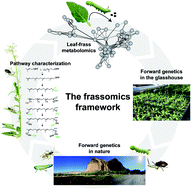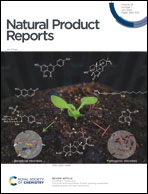Harmonizing biosynthesis with post-ingestive modifications to understand the ecological functions of plant natural products
Abstract
Covering: up to 2022
The recent dramatic advances in our understanding of the biosynthetic pathways that produce diverse bouquets of plant-derived natural products have far surpassed our understanding of the function of these compounds for plants: how they influence a plant's Darwinian fitness in nature. Our understanding of their mechanisms, the life-processes targeted by these compounds, is similarly poorly resolved. Many plant specialized metabolites (PSMs) are further modified after ingestion by herbivores, and these post-ingestive modifications are frequently essential for PSM function. Here we summarize the biosynthesis and functional mechanisms of 17-hydroxygeranyllinalool diterpene glycosides in the ecological model plant Nicotiana attenuata, and summarize the post-ingestive modifications known from other two-component PSMs. We propose that parallel comparisons of plant natural product biosynthetic pathways and insect post-ingestive metabolism of the same plant tissues (“frassomics”) will facilitate the often-elusive identification of the molecular targets of these effective chemical defenses, contribute to elucidations of post-ingestive metabolite interactions in insect guts, and predicate the rapid evolutions of resistance against insecticides inspired by PSMs. We highlight the value of conducting these parallel investigations at the level of the entire metabolome so as to include the multiple interacting pathways in both natural product biosynthesis as well as their post-ingestive processing. We introduce the concept of frass metabolite QTL (fmQTL) analysis that integrates powerful forward genetic approaches with frassomics, and suggest that insect-guided high-throughput forward- and reverse-genetics approaches in natural habitats will advance our understanding of PSM biosynthesis and function.

- This article is part of the themed collection: Plant Natural Product Biosynthesis and Biotechnology


 Please wait while we load your content...
Please wait while we load your content...